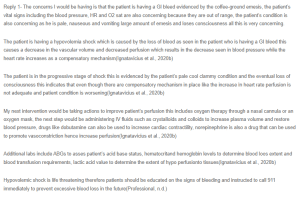Response – Management of GI Bleed Leading to Hypovolemic Shock
Hello,
Thank you for the insightful post highlighting the management of a patient with a gastrointestinal (GI) bleed leading to hypovolemic shock. The observations regarding the patient’s clinical signs, such as coffee-ground emesis and hypotension, are indeed alarming and indicative of a life-threatening condition. It is important to consider early intervention to prevent further deterioration. Using vasopressors like norepinephrine is crucial in maintaining perfusion pressure when insufficient fluid resuscitation alone (VanValkinburgh & McGuigan, 2019). Also, monitoring central venous pressure (CVP) can guide fluid management and avoid fluid overload, which could worsen the patient’s condition. Additionally, non-invasive ventilation might be considered if the patient’s respiratory status deteriorates, ensuring adequate oxygenation until definitive care is provided. Further, education on early signs of GI bleeding and medication adherence is essential to prevent recurrence. Such an approach is effective as it considers different dimensions of the patient’s state, providing higher rates of effective treatment.
References
VanValkinburgh, D., & McGuigan, J. J. (2019). Inotropes and vasopressors. Nih.gov; StatPearls Publishing. https://www.ncbi.nlm.nih.gov/books/NBK482411/
ORDER A PLAGIARISM-FREE PAPER HERE
We’ll write everything from scratch
Question
Reply 1- The concerns I would be having is that the patient is having a GI bleed evidenced by the coffee-ground emesis, the patient’s vital signs including the blood pressure, HR and O2 sat are also concerning because they are out of range, the patient’s condition is also concerning as he is pale, nauseous and vomiting large amount of emesis and loses consciousness all this is very concerning.

Management of GI Bleed Leading to Hypovolemic Shock
The patient is having a hypovolemia shock which is caused by the loss of blood as seen in the patient who is having a GI bleed this causes a decrease in the vascular volume and decreased perfusion which results in the decrease seen in blood pressure while the heart rate increases as a compensatory mechanism(Ignatavicius et al., 2020b)
The patient is in the progressive stage of shock this is evidenced by the patient’s pale cool clammy condition and the eventual loss of consciousness this indicates that even though there are compensatory mechanism in place like the increase in heart rate perfusion is not adequate and patient condition is worsening(Ignatavicius et al., 2020b)
My next intervention would be taking actions to improve patient’s perfusion this includes oxygen therapy through a nasal cannula or an oxygen mask, the next step would be administering IV fluids such as crystalloids and colloids to increase plasma volume and restore blood pressure, drugs like dobutamine can also be used to increase cardiac contractility, norepinephrine is also a drug that can be used to promote vasoconstriction hence increase perfusion(Ignatavicius et al., 2020b)
Additional labs include ABGs to asses patient’s acid base status, hematocritand hemoglobin levels to determine blood loos extent and blood transfusion requirements, lactic acid value to determine the extent of hypo perfusionto tissues(Ignatavicius et al., 2020b)
Hypovolemic shock is life threatening therefore patients should be educated on the signs of bleeding and instructed to call 911 immediately to prevent excessive blood loss in the future(Professional, n.d.)

